_______________________________________________________________________________________________________________
OVERVIEW:
 The Carmacks Copper Belt is a linear stretch of intrusion hosted Cu (+/- Au-Ag-Mo) mineralization in the Dawson Range of south-central Yukon Territory. Centered on the Minto Mine, the belt extends from north of the Yukon/Pelly River confluence southeast to the community of Carmacks. The occurrences are hosted in, or close to the contacts of, intermediate to felsic intrusive and meta-intrusive rocks of the Early Jurassic Minto Suite.
The Carmacks Copper Belt is a linear stretch of intrusion hosted Cu (+/- Au-Ag-Mo) mineralization in the Dawson Range of south-central Yukon Territory. Centered on the Minto Mine, the belt extends from north of the Yukon/Pelly River confluence southeast to the community of Carmacks. The occurrences are hosted in, or close to the contacts of, intermediate to felsic intrusive and meta-intrusive rocks of the Early Jurassic Minto Suite.
At the Carmacks North target area, Minto Suite granitoid is the dominant rock type. It is cut by aplite, microgranite and pegmatite dykes and contains lenses of foliated to gneissic quartz-feldspar-hornblende-biotite granodiorite which contain most of the mineralization. Locally outcrops of Carmacks volcanics overlie and mafic intrusions intrude the other rock types.
There are 3 advanced and 7 early-stage zones of mineralization on the Carmacks North target area. Copper mineralization (with occasional Au or Ag) is contained in foliated to gneissic granodiorite. Copper sulphides occur within the foliated granodiorite and gneiss where they replace mafic minerals. Copper bearing minerals malachite, azurite, chalcopyrite, bornite, chalcocite and tenorite (copper wad) have been observed in hand samples and drill core. Magnetite is locally abundant in both mineralized and unmineralized rock. The highest gold and silver values are associated with bornite-rich sections.

